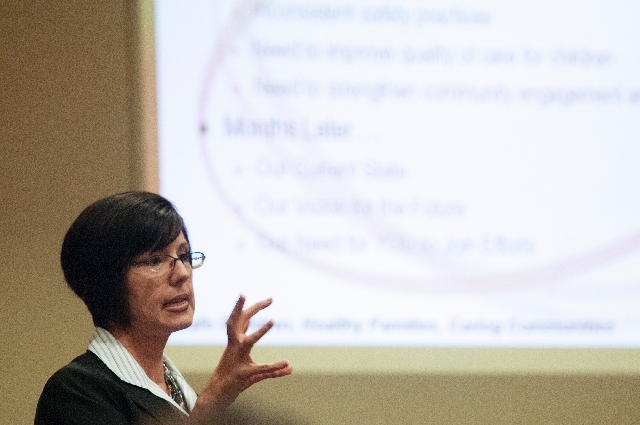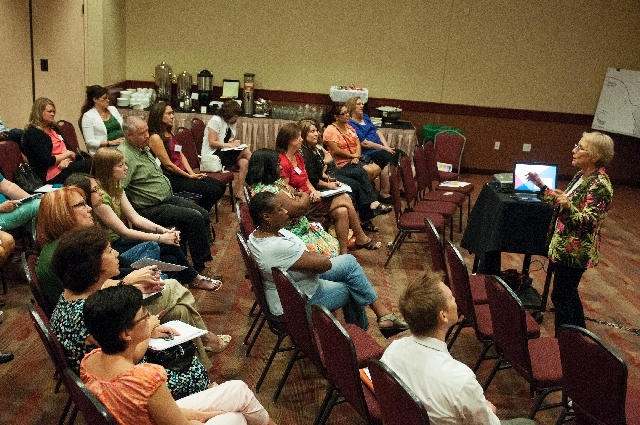Clark County Family Services faces challenge in housing ‘crossover’ youth
No kid ends up in Clark County Family Services’ care because life at home is great.
Those in protective custody or foster care may have parents who hurt them or let them go hungry. The children did nothing wrong.
Other residents at facilities Family Services oversees are referred by another county department: Juvenile Justice Services. Their trouble with the law is complicated by their family situations.
In child welfare circles, children and teens who overlap both departments are referred to as “crossover.” Those who fall into both categories can have histories of behavioral problems that present difficulties for those tasked with housing them and keeping them safe.
Observers say those complexities may have contributed to incidents this summer that prompted the public to question whether children in county care are safe. Family Services, which sought input and buy-in of its overall mission last week in a series of community meetings, emphasized that it handles each child’s housing on a case-by-case basis.
In June, a group of siblings walked off Family Services’ Child Haven campus and staff didn’t — they argue couldn’t — stop them. The emergency shelter for abused or neglected children is not a detention center, officials said, and kids aren’t imprisoned, held down or otherwise forced to stay.
Then earlier this month, county administration acknowledged Family Services is investigating a group home operated by A Brighter Day Family Services, whose facilities are licensed and used by the county. The investigation became known after a state lawmaker asked county officials to investigate allegations ranging from inappropriate touching involving juveniles to the availability of alcohol and tobacco, most connected to A Brighter Day.
Family Services leaders have not spoken publicly about that.
Both facilities house crossover kids at one time or another. Last week, four girls ages 15 to 17 were staying at the group home under investigation. Three were placed there by Family Services, and one by Juvenile Justice.
“I think that’s one of the problems, when you’re mixing populations,” said Esther Brown, a children’s advocate for The Embracing Project.
They are not always well-supervised, and that’s a problem with staff training, said Brown, who formerly contracted with Clark County courts to serve as a liaison between providers, courts, Family Services and Juvenile Justice Services.
Family Services tries not to mix the three populations of youth in county care, department Director Lisa Ruiz-Lee said on Friday, and there are facilities designated specifically for the crossover population. But it’s not as simple as that.
“I don’t think you can say there’s a hard and fast rule that you never ever should mix those populations,” Ruiz-Lee said. “It’s about meeting the needs of the individual children and youth and seeing if they align well with one another, and is the placement a safe, appropriate place to be.”
balancing competing priorities
Family Services staff often must balance competing priorities, Ruiz-Lee said. In the case of the five Nicholas siblings — who, at ages 7 to 14, fled Child Haven but were returned, unharmed, 24 hours later — the choice was between avoiding restraint and protecting children from making a decision that could put them in danger.
Avoiding restraint won.
That was no easy decision.
“There were a lot of tears when these five kids ran off this campus,” Ruiz-Lee said after the incident.
Family Services leaders said staff followed protocol in letting the children walk, and a state review backed that stance and also showed other states, such as Texas and Illinois, had similar policies. Nevada and federal laws say children in facilities like Child Haven should be restrained only in emergencies.
Clark County Assistant Manager Jeff Wells, who oversees Family Services and Juvenile Justice Services, said employees of both departments know how to handle situations that come their way with the about 7,200 teens and children they are involved with on a daily basis. They receive training on appropriate laws, including the Nevada Foster Child Bill of Rights, that govern the use of restraints.
Even if Child Haven workers were POST-certified — the type of training law enforcement agents receive — they couldn’t use police tactics to subdue a child.
“They still would not be allowed to go in and tie the kid down to a chair,” Wells said. “This is a practical reality.”
Ruiz-Lee doesn’t expect Clark County to change practice or policy to include restraining children by force, be that locked doors or staffers’ hands.
“When you restrain children, you run the risk of doing them harm whether you mean to or not,” Ruiz-Lee said after the June incident. “Keeping them safe, I think, means doing them no more physical harm than they have already been done.”
But a California attorney representing children who have been in Clark County Family Services’ care says federal child care law makes safety the top priority. A lawsuit was filed in 2010 and remains open. It accuses Family Services of failing to provide medical and mental health care, failing to investigate foster home abuse and neglect allegations, and failing to provide an advocate for court hearings.
“If you would let kids walk away from you into a dangerous environment, you are not complying with the federal mandate,” said Bill Grimm, senior attorney for the National Center for Youth Law. “You are disobeying the federal mandate.”
Clark County District Judge William Voy, who presides over juvenile court, said getting and keeping children in a safe place is Family Services’ responsibility. There can be tension, he said, because sometimes kids who have been in trouble with the law are harder to place in foster care.
But to him that’s no excuse.
“There’s no reason why they shouldn’t be able to handle the kids they’ve got over there, including the kids I send them,” Voy said. “We’re dealing with a lot of the same kids, you know?”
If there were more kids than usual in detention or if they required closer supervision, Voy said, managers would bring in extra staff.
During the first six months of this year, Voy sent about 50 children who have been in his courtroom to the emergency shelter, according to Child Haven’s calculations. Sending kids who have gotten into trouble to Child Haven or foster homes could happen because their family home may not be safe.
The offenses involved span a wide spectrum and Voy takes the circumstances into account. Multiple trips to the juvenile detention center could be viewed by the judge as a level of sophistication on the perpetrator’s part — even if it’s for a minor infraction such as spray-painting graffiti on public property. So Voy could choose not to send the offender into a setting shared by children housed for protection. A more serious but solitary offense could result in a kid being housed with crossovers if Voy doesn’t see a threat posed.
Sometimes kids go from Family Services to detention.
That can mean a child in protective services has hurt an adult employee.
Earlier this year, one of the youths at Child Haven bit a chunk out of a staffer’s arm, Ruiz-Lee told the Review-Journal. In another case, a 7-year-old girl with mental issues attacked an instructor who, as a result, had to have his knee reconstructed.
In Nevada, a child must be at least 8 to face criminal charges.
Training teaches employees who need to stop a violent child to hold them in a hug so that their arms can’t flail and their legs can’t kick.
“This is one of the toughest jobs, one of the toughest arenas of public service, that you will ever encounter,” Ruiz-Lee said. “You can have the best training in the world, but if you have a very aggressive child or a very aggressive youth, all bets are off.”
‘our youth deserve better’
Ultimately, Family Services’ goal is to keep kids in as stable a home as possible. Child Haven, as an in-take center for kids awaiting more permanent housing, doesn’t fit that objective.
The department has a continual push for more quality foster homes, and that was part of the theme for last week’s child welfare summit, which was not open to the public but was billed as meetings for community stakeholders. More than 200 people, including law enforcement officers, foster parents and human services workers, attended the three-day event.
“Our youth deserve better,” Ruiz-Lee said. “They deserve to be integrated into the community and to participate in everyday life the way any other child and adolescent would be able to.”
Family Services and Juvenile Justice are “in sync” when it comes to a child’s placement, Ruiz-Lee said.
Department of Juvenile Justice Services Director Jack Martin agrees. He attended the summit Wednesday and praised Family Services for its collaboration.
“It was refreshing to see county agencies reaching out to the community,” Martin said. “This wasn’t just about foster care. This is about providers and everybody looking at the child.”
Grimm, the attorney involved in the lawsuit against Family Services and who did not attend the summit, is skeptical.
“Soliciting community input is a step in the right direction,” he said. “But if the purpose of conducting these community meetings is solely for public relations purposes and the agency doesn’t take the suggestions and recommendations that it gathers from the community, then that would bother me.”
The Family Services child welfare summit was a follow-up to collected comments and suggestions from a similar event in 2011. Among the goals attendees two years ago named were more comprehensive approaches to child welfare and health.
“It’s really about rethinking the way we do business with families in the community,” Family Services spokeswoman Kristi Jourdan said. “Right now the way some folks think we do child welfare is investigate the bad guys and then save the kids. But it’s not about finger-pointing. It’s more of an intervention, making sure children are safe.”
Contact reporter Adam Kealoha Causey at acausey@reviewjournal.com or 702-383-0401. Contact reporter Yesenia Amaro at yamaro@reviewjournal.com or 702-383-0440.





























